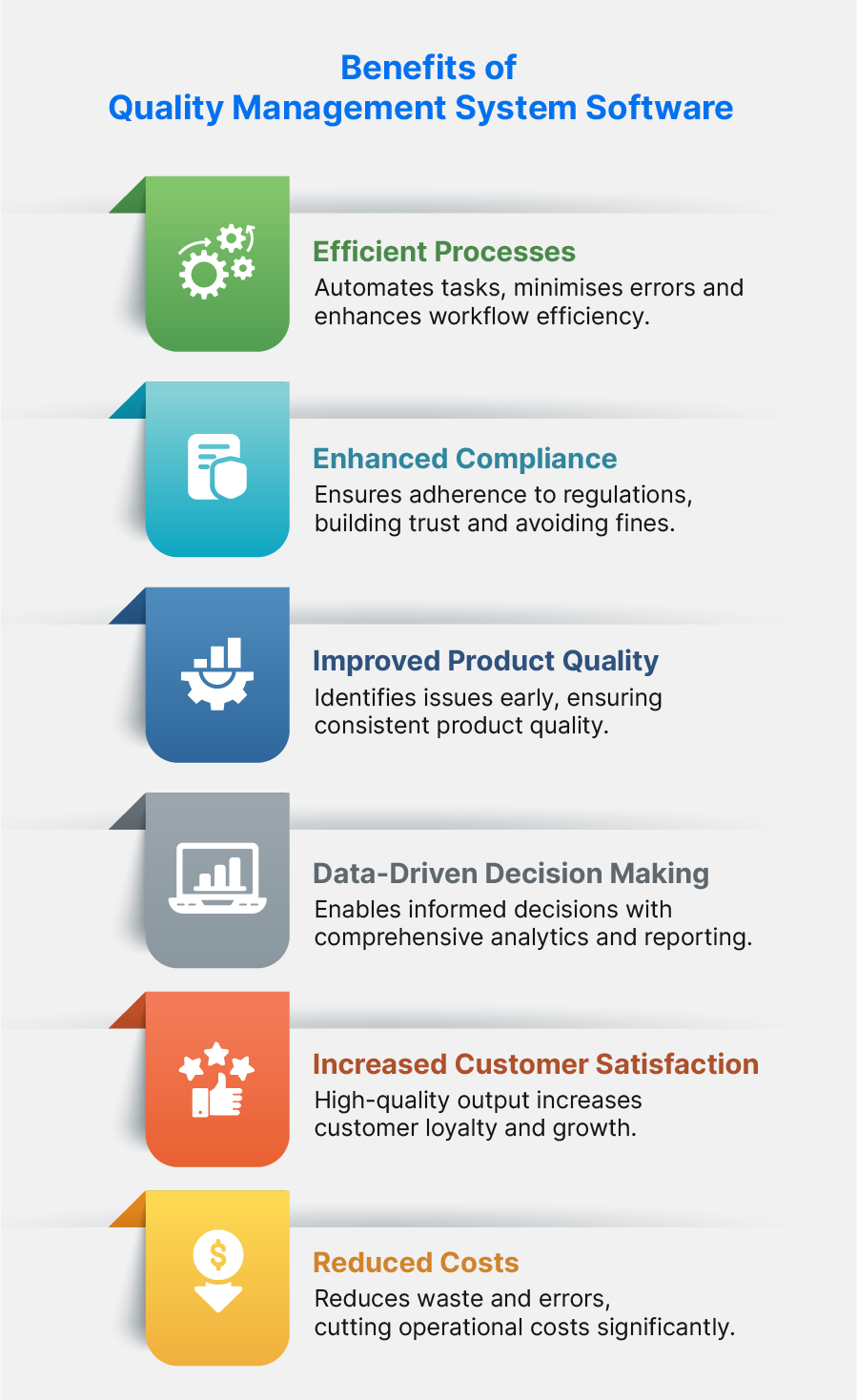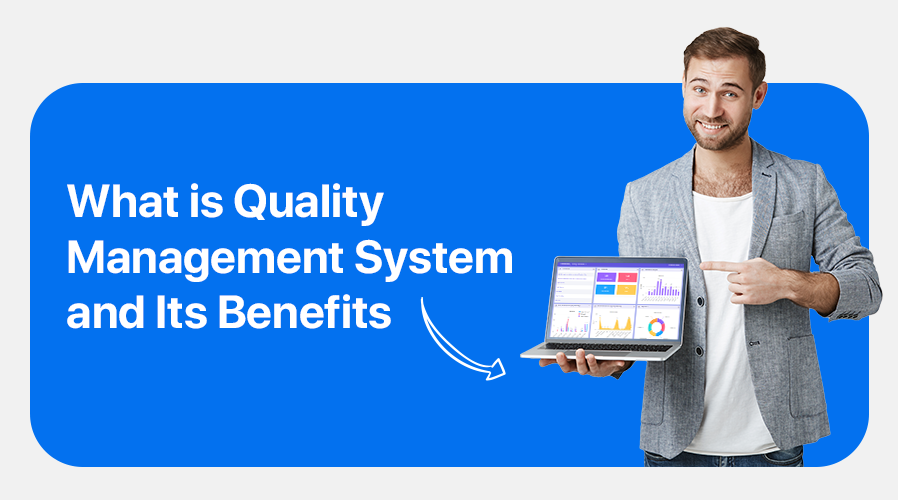Building a business in today’s competitive market environment means adhering to strict quality standards. As you navigate various markets you will be faced with the demand for superior quality and reliability. This demand means that you need a framework to help you meet and exceed customer and stakeholder expectations.
The framework in question here is a Quality Management System (QMS). When grounded in a Quality Management System principle, your organisation can focus on achieving quality excellence, continuous process improvement and unmatched efficiency.
In this article, we explore how the adoption of a quality management system framework can help you implement quality management processes, monitor them and identify areas for improvement.
What is a Quality Management System?
A Quality Management System (QMS) is a structure that manages the policies, processes and procedures of your organisation. This management is required for planning and execution of various business activities in a way that meets quality standards and requirements. It should align with an organisation’s purpose and strategic direction.
For example, a pharmaceutical company might use its quality management system for medical devices and the pharmaceutical industry to oversee the entire lifecycle of a drug, from raw material sourcing through manufacturing to distribution. This systematic compliance and quality control make it convenient to identify and fix issues before they affect the consumer.
Quality Management System Objectives
The objectives of a QMS aim to:
1. Ensure Compliance
Achieve and maintain compliance with industry-specific regulations and standards, specifically with ISO 9001 and similar standards.
2. Enhance Customer Satisfaction
Consistently meet customer expectations for product quality and reliability.
3. Improve Process Efficiency
Streamline processes to reduce waste, decrease costs and increase productivity.
Components of a Quality Management System Software
Implementing a Quality Management System (QMS) involves several components that ensure its compliance with QMS standards. These components help your organisation meet quality management system requirements and facilitate growth and improvement. Let’s take a closer look at the components of a QMS software:

1. Non-Conformance
Tracking non-conformance in the organisation is at the heart of QMS software. Non-conformance means deviations from established standards and quality requirements. In an organisation, non-conformance could lead to consequences such as wastage of resources, inefficiency, hefty fines and penalties.
The QMS software helps identify, document and manage any deviations from QMS standards and procedures.
2. Operations
The operations component within a QMS software monitors all production and delivery related processes of products or services. It ensures that every operational activity aligns with the overall quality objectives to enhance efficiency and consistency across the board.
3. Auditing
Auditing is an essential process within the QMS framework. It provides an objective assessment of how well your organisation adheres to quality management system requirements. Through regular QMS audits, companies can identify areas for improvement and verify the effectiveness of their QMS. This type of regular verification ensures compliance.
4. Real-Time Monitoring
Real-time monitoring capabilities allow your organisation to track quality metrics and performance indicators as they happen. This immediate visibility into operations helps you identify potential quality issues before they escalate. This lowers downtime and cuts on losses.
5. Data Collection and Analytics
Data collection and analytics are vital for informed decision-making in quality management. This component of QMS software enables your organisation to gather, store and analyse quality-related data from various sources. Insights derived from this data help in understanding trends and predicting potential issues to make improvement.
6. Risk Management
Risk management within QMS software involves identifying, assessing and minimizing risks that could affect product quality or compliance. By proactively managing risks, you can prevent issues, ensure product safety and maintain customer trust.
7. Document Management
Effective document management ensures that all quality-related documents, including policies, procedures and records, are properly organised, controlled and accessible. This facilitates easy retrieval of information and supports compliance during QMS audits.
What are the Benefits of Using Quality Management Systems Software?
Adopting a quality-focused approach in your organisation has many advantages. These include enhanced operational efficiency, increased customer satisfaction and improved regulatory compliance. However, to implement such an approach, having a quality management system in place is vital.
Here are the reasons why QMS software is a valuable addition to your organisation:

1. Efficient Processes
QMS software streamlines all your business processes. It automates routine tasks, reduces manual effort and minimises the chances of errors. This leads to a more efficient workflow where resources are optimally utilised and processes are executed reliably.
2. Enhanced Compliance
Staying compliant with industry standards and regulations is a breeze with QMS software. It keeps you updated with the latest regulations and ensures your processes adhere to these guidelines. This not only helps avoid legal issues but also helps builds trust within your customers and stakeholders.
3. Improved Product Quality
The core benefit of QMS software is its impact on product quality. It provides tools for continuous monitoring and analysis which means you can identify quality issues early and address them promptly. This proactive approach ensures that your products consistently meet quality expectations.
4. Data-Driven Decision Making
With QMS software, your decisions are always backed by data. It offers comprehensive analytics and reporting features that give you insights into your quality management performance. This information allows you to make informed decisions, prioritise improvements and track the effectiveness of your strategies over time.
5. Increased Customer Satisfaction
QMS software helps you increase customer satisfaction by making sure that your products and services are of the highest quality. This leads to increased customer loyalty and growth.
6. Reduced Costs
Finally, QMS software helps in lowering operational costs by optimising your processes and reducing the likelihood of errors and defects. The savings from reduced waste, fewer product recalls and less rework contribute directly to improving your bottom line.
Final Thoughts
Implementing a Quality Management System (QMS) software helps enhance your organisation's ability to meet and exceed quality standards. It ensures compliance, improves process efficiency and boosts customer satisfaction.
To effectively implement QMS software, it's crucial to understand your organisation's needs and objectives. This involves identifying the critical processes that need to be managed and monitored, setting clear quality objectives and ensuring that all staff are trained and engaged in the quality improvement process.
Effivity's QMS software is designed to be user-friendly, facilitating quick setup and ease of use. This facilitates broad adoption within your organisation. It offers an all-in-one solution that covers all aspects of quality management, from document control and risk management to internal audits and non-conformance tracking. With features like configurable dashboards, automated alerts and the ability to integrate with existing systems, Effivity streamlines your quality management processes, which makes it easier to identify areas for improvement and make changes effectively.
For more information on Effivity's QMS software and to start your free trial, visit Effivity and schedule a consultation with our team today!






























